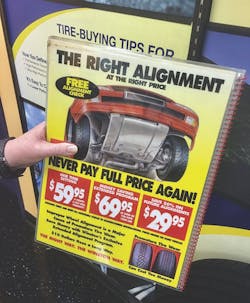Customers are pretty smart; actually, they always have been. I’m picking up lately on an idea that’s floating around: Running a business was easier in the good old days, and advertising, in particular, is harder now (which it is) than it used to be.
I recently read an article written by a young columnist. He believes it was simpler before the internet; you just blah, blah, blah, and presto, customers showed up at your store. I’ve been around long enough to know that it didn’t happen quite the way they think it did. I sure don’t remember it that way. It has always required effort, attention, focus, investments in advertising, and good customer service for the phone to ring or a customer to visit.
Today, as we all know, customers research online before making purchases, big or small. It seems like customers are smarter today, but I think they just have more information. In our race to make everything more convenient, the world on many levels has become more complex. So although many things are new and improved, it’s hard to compare; customers want to know how new is new and how much better is new and improved.
“Am I paying more for minor improvements?” The reason consumers are asking these types of questions is because many products and services today don’t deliver the value they promise. With all the technological advances and bigger/better promises that don’t deliver, it’s easy to understand consumers’ jadedness. If a product or service advertisement states that something is easy, it’s probably because they want you to “believe” it’s easy.Often promises are distractions and offer little additional value. Let me say that again: Often promises are distractions that offer little, if any, additional value.
If you are choosing to offer consumers added-value items, you best be ready to back it up on the spot (to close the sale) and down the road when customers return to exercise their promised service or warranty!
I’ve been reading about a phenomenon effecting consumers that we as an industry should be aware of. It’s called “add-on fatigue.” We have all experienced this on both sides of the counter. As consumers purchasing products at big box retailers (aka Home Depot or Best Buy), we are frequently asked, “Would you like to add our product protection plan?”
They continue with a half-hearted pitch, and if you show any interest, the pitch continues. If you’re not interested, then the cashier usually says something like, “Most people decline.”
Retailers everywhere are offering add-ons, and consumers are becoming fatigued by all the endless offers. For example, the ice maker in my Samsung refrigerator stopped producing ice. I had purchased it from Sears, so I made a call to Sears to schedule a repair. On the first visit, the technician repeatedly offered me a warranty that would save me $100 on the repair, but would also enroll me in a monthly charge of “ONLY $$” that would “SAVE ME $$” in the future.
He offered it four times, and at the end of the unsuccessful service visit (he didn’t have the part on the truck), he asked me to sign a printout to acknowledge I had declined the warranty. He then took a picture of the signed printout with his cell phone and sent it to his office. I was fatigued by the exercise, and I could tell the technician was also.
If you currently offer or intend to offer added-value add-ons, I strongly recommend that these items, such as road hazard or extended alignments, must represent real value as opposed to fake value. Remember, customers are smart; they are on the lookout for fake value, and they understand real value.
Add-ons must have value on both sides of the counter. It’s been my experience that value-adds not adding enough value have a high rejection rate. This causes another problem. The customer must turn it down and feel the subsequent fatigue associated with the turndown. The fatigue is then felt on both sides of the counter.
I’ve worked with and for companies that have required their sales staff to offer “valueless-value” over and over again at the counter, all day every day. Fatiguing! Added-value offers must first represent real value to the consumer, and they must be easy to present and easy to understand. If the add-on is difficult to present and hard to understand, then the success rate will fail, followed by more half-hearted presentations and more failure.
No fake value. Deliver real value with skill and enthusiasm. It’s less fatiguing and more rewarding.
Leaders lead, winners win. ■
Wayne Williams is president of Wayne Williams Marketing, a marketing and branding company with emphasis on retail “counter intelligence.” Located in La Habra, Calif., he can be reached via email at [email protected].
To read more Counter Intelligence columns, click:
Training Covers Strategy, Process and Execution
'Go Online,' They Said, "It's Easier': We're Caught in the Transformational Global Vortex
Branding Is a Beacon: The TIme Is Right for You to Rethink and Rebrand
We Are Retailers: We Must Keep an Eye on the Details in Retail

